Related Research Articles

County Donegal is a county of Ireland in the province of Ulster and in the Northern and Western Region. It is named after the town of Donegal in the south of the county. It has also been known as County Tyrconnell, after the historic territory of the same name, on which it was based. Donegal County Council is the local council and Lifford the county town.

Killybegs is a town in County Donegal, Ireland. It is the largest fishing port in the country and on the island of Ireland. It is located on the south coast of the county, north of Donegal Bay, near Donegal Town. Its Irish name Na Cealla Beaga means 'little cells', a reference to early monastic settlements. The town is situated at the head of a scenic harbour and at the base of a vast mountainous tract extending northward. In the summer, there is a street festival celebrating the fish catches and incorporating the traditional "Blessing of the Boats". As of 2016, the population was 1,236.

Cill Charthaigh is a Gaeltacht village on the R263 regional road in the south west of County Donegal in Ireland. It is also a townland of 233 acres and a civil parish in the historic barony of Banagh.
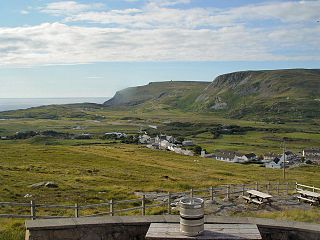
Gleann Cholm Cille, anglicised as Glencolumbkille or Glencolmcille, is a small district on the Atlantic coast of southwest County Donegal in Ulster, the northern province in Ireland. Named after Saint Colm Cille (Columba), it is also a civil parish in the historic barony of Banagh. Glencolmcille is in the Gaeltacht, and while it remains an Irish-speaking community, English has been steadily replacing Irish as the main language, with only 34% of residents speaking Irish on a daily basis in 2002. The village of Cashel is the main settlement in the district.
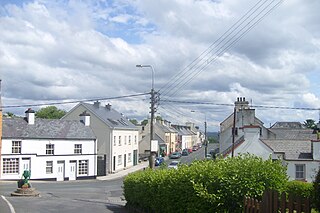
Mountcharles is a village and townland in the south of County Donegal, Ireland. It lies 6 km from Donegal Town on the Killybegs road (N56). It is situated in the civil parish of Inver and the historic barony of Banagh. The village's name is usually pronounced locally as 'Mount-char-liss'.
Clan Sweeney is an Irish clan of Scottish origin. The Mac Suibhne family did not permanently settle in Ireland before the beginning of the 14th century, when they became Gallowglass soldiers for the Ua Domnaill dynasty of Tír Chonaill. The clan also claims an Irish descent from a prince of the Uí Néill dynasty, Ánrothán Ua Néill, son of Áed, son of Flaithbertach Ua Néill, King of Ailech and Cenél nEógain, died 1036. Through this descent the clan can claim a descent from Niall Noigíallach.
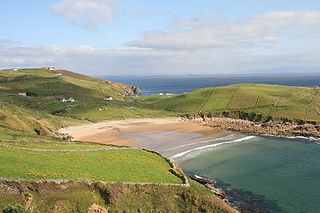
Muckross Head is a small peninsula in the parish of Kilcar about 10 km west of Killybegs, County Donegal, in north-western Ireland. It contains a popular rock-climbing area, noted for its unusual horizontally layered structure.

Portnablagh is a small village in County Donegal in Ulster, the northern province in Ireland. Portnablagh is located on the north-west coast of County Donegal, specifically the west side of Sheephaven Bay. It is on the N56 road.

Banagh is a historic barony in County Donegal in Ireland. Patrick Weston Joyce said the name Banagh came from Enna Bogaine, son of Conall Gulban, son of Niall of the Nine Hostages. It was created along with Boylagh when the former barony of Boylagh and Banagh was split in 1791 by an Act of the Parliament of Ireland.

The Wild Atlantic Way is a tourism trail on the west coast, and on parts of the north and south coasts, of Ireland. The 2,500 km driving route passes through nine counties and three provinces, stretching from County Donegal's Inishowen Peninsula in Ulster to Kinsale, County Cork, in Munster, on the Celtic Sea coast.
The Battle of Doire Leathan took place on 14 September 1590 at Doire Leathan, a townland and hamlet located between Kilcar and Carrick in south-western County Donegal in Ulster, Ireland. Derrylahan is on the eastern shores of Teelin Bay, being just across from the village of Teelin. The battle was part of the ongoing succession dispute for the leadership of the Gaelic lordship of O'Donnell. A combined force of Irish clans and Scottish Redshank mercenaries hired by Iníon Dubh defeated and killed Sir Domhnall Ó Domhnaill. The Tanist of Tír Conaill, Sir Domhnall's younger half-brother and Iníon Dubh's son, Red Hugh O'Donnell, was still imprisoned in Dublin Castle, but later rose following a subsequent escape to lead Clan O'Donnell and was a prominent figure during the Nine Years War.
Dunaff is a townland in the Urris Valley, located in the North-West corner of the Inishowen Peninsula.

Boyeeghter Strand or Boyeeghter Bay, commonly known as TheMurder Hole Beach, is a beach situated on Rosguill, a peninsula located on the north coast of County Donegal in the north-west of Ulster, the northern province in Ireland. The beach lies at the north-eastern end of Rosguill, being located near Melmore Head. It has cliffs, hills, dunes, and small caves. When the tide is in there are two beaches, which merge into one when the tide is out. Rough Island is a small tidal island located approximately 15 metres offshore. The beach is not suitable for swimming.
The Burn Dale is a burn or small river in the east of County Donegal in Ulster, the northern province in Ireland. The burn is also known in English as the Dale Burn, the Burn Deele, the Burndale River, the Deele River or the River Deele. In the Ulster Scots dialect, a 'burn' is a stream or small river.

The Finn River, also known as the River Finn, is a small river that flows through parts of County Fermanagh and parts of County Monaghan in the south of Ulster, the northern province in Ireland. In certain places, the river forms part of the boundary between County Fermanagh, which is part of Northern Ireland, and County Monaghan, which is part of the Republic of Ireland. Two very short stretches of the river, just north of Redhills and at Castle Saunderson, near Belturbet, also form part of the boundary between County Fermanagh and County Cavan. This means that some stretches of the river form part of the border between Northern Ireland and the Republic of Ireland, these short stretches also forming part of the external border of the European Union.

Cuillaghan is a townland in the civil parish of Drumlane, Barony of Loughtee Lower, County Cavan, Ireland.
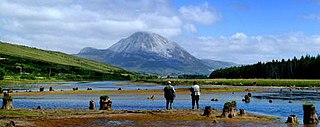
The Clady River is a small river in Gweedore, a district in the north-west of County Donegal in Ulster, the northern province in Ireland. The river flows entirely within the Civil Parish of Tullaghobegly.
The Drumenny Burn, also known as the Drumonny Burn, the Drumenny River, the Drummenny River or the Drimminy River, is a burn in the south of County Donegal in Ulster, the northern province in Ireland. The lower stretch of the burn flows around the eastern edge of Donegal Town, where it flows into the River Eske. In the Ulster Scots dialect, a 'burn' is a stream or small river. The Drumenny Burn probably takes its name from the townland of Drumenny Upper, through which it flows, or else from the townlands of Drumenny Middle and Drumenny Lower, around the edges of which it flows. Almost all of the burn flows within the Civil Parish of Donegal.
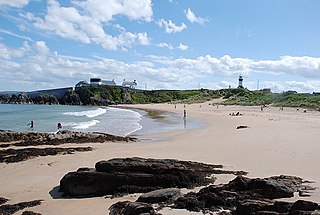
Shrove is a coastal hamlet and townland in Inishowen in the north of County Donegal in the north-west of Ulster, the northern province in Ireland. The hamlet is located a short distance to the north of Greencastle in the north-east of Inishowen, a peninsula on the north coast of Ireland. The name of both the hamlet and the townland is also sometimes written as Shroove, and is sometimes written as Stroove by some government bodies.
Wattlebridge, sometimes written as Wattle Bridge, is a small hamlet in the south-south-east of County Fermanagh in Northern Ireland. The hamlet is located almost 3½ miles south of the village of Newtownbutler. The hamlet is in a region known unofficially as South Ulster.
References
- 1 2 3 4 5 6 7 8 9 Sheet 10 (5th Edition) (Map). Discovery Series. Dublin: Ordnance Survey of Ireland. 2020.
- 1 2 3 4 5 6 7 8 9 "How To Find Donegal's Secret Waterfall (Parking, Route + Tide Times)". The Irish Road Trip.
- 1 2 3 4 5 6 7 "Early-stage plans for safer path to Donegal's "Secret Waterfall"". Donegal Daily. 14 May 2022.
- 1 2 Townlands.ie: Largy. https://www.townlands.ie/donegal/banagh/upper-killybegs/crownarad/largysillagh/largy/
- ↑ Patrick McKay, A Dictionary of Ulster Place-Names, p. 25 (see entry for 'Blacklion') and p. 153. The Institute of Irish Studies, The Queen's University of Belfast, Belfast, 1999.
- 1 2 Donegal Daily: 'Couple discover hidden ethereal waterfall in South Donegal' (25 June 2017). https://www.donegaldaily.com/2017/06/25/couple-discover-hidden-ethereal-waterfall-in-south-donegal/
- ↑ Townlands.ie: Largysillagh Townland, Co. Donegal. https://www.townlands.ie/donegal/banagh/upper-killybegs/crownarad/largysillagh/
- ↑ Patrick McKay, A Dictionary of Ulster Place-Names, p. 31 (see entries for 'Burnfoot' and 'Burntolet River') and p. 150. The Institute of Irish Studies, The Queen's University of Belfast, Belfast, 1999.
- 1 2 Donegal Daily: 'Extreme care advised around "Secret Waterfall" location' (17 May 2021). https://www.donegaldaily.com/2021/05/17/extreme-care-advised-around-secret-waterfall-location/
- 1 2 3 Brian Lac[e]y et al. , Archaeological Survey of County Donegal, p. 140 (Fig. 73e) and p. 325 (monument number 1870: Largysillagh). Donegal County Council, Lifford, 1983.